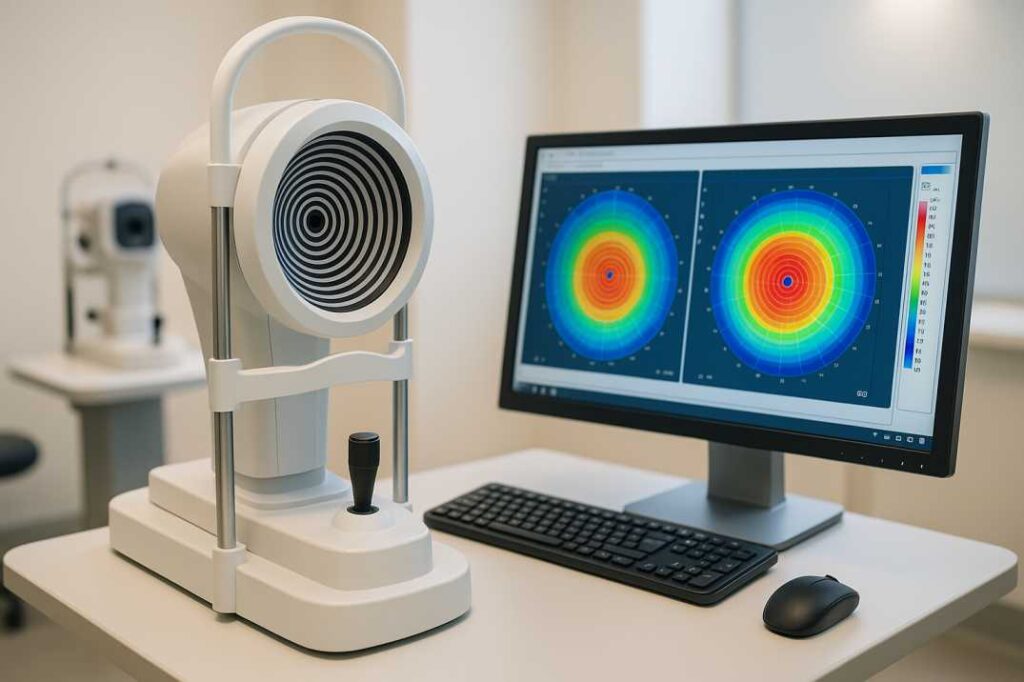LASIK Surgery Consultation Guide 2025 | Evaluation
Bottom Line Up Front: A LASIK surgery consultation typically takes 2-3 hours and involves comprehensive eye testing, health screenings, and detailed measurements to determine if you’re a good candidate for vision correction. This thorough evaluation examines corneal thickness, tear film quality, refractive errors, and overall eye health to create a personalized treatment plan—ultimately helping you make an informed decision about life-changing vision improvement.
At Cannon EyeCare’s Seattle locations in University Village and Pike Place Market, we combine Midwestern hospitality with advanced LASIK evaluation technology to provide unhurried, comprehensive consultations that help you make confident decisions about your vision.
Understanding Your LASIK Surgery Consultation
Thinking about saying goodbye to glasses and contact lenses? Your journey to clearer vision starts with a comprehensive LASIK surgery consultation. This detailed evaluation is far more than a routine eye exam—it’s a sophisticated assessment that determines whether laser vision correction is right for your unique eyes and lifestyle.
The consultation serves as your roadmap to a better vision. During this appointment, your eye care provider will gather extensive data about your eyes’ health, structure, and visual capabilities. This information guides every decision about your potential LASIK surgery, from candidacy to customized treatment planning.
Why the LASIK Consultation Takes Time
You might wonder why your LASIK consultation requires 2-3 hours when a regular eye exam takes much less time. The answer lies in the level of detail required for surgical planning.
Unlike standard vision screenings, LASIK evaluations involve advanced diagnostic technology that creates incredibly precise measurements of your entire visual system. These high-resolution scans can assess eye tissue at the micron level, capturing information that determines three critical factors: your overall eye health, whether LASIK is recommended for your specific situation, and—if you proceed—the exact parameters for your customized treatment.
How Do I Prepare for My LASIK Consultation?
Proper preparation ensures you get the most accurate evaluation and useful information from your consultation appointment.
Contact Lens Removal Guidelines
If you wear contact lenses, you’ll need to stop using them before your baseline evaluation. Contact lenses temporarily change your cornea’s shape, and wearing them too close to your consultation can lead to inaccurate measurements, poor surgical planning, and disappointing vision outcomes.
Follow these contact lens removal timelines:
- Soft contact lenses: Stop wearing 2 weeks before your consultation
- Toric soft lenses or rigid gas permeable (RGP) lenses: Discontinue at least 3 weeks prior
- Hard lenses: Remove at least 4 weeks before evaluation
Switch to wearing your glasses full-time during this preparation period.
What to Bring to Your Appointment
Come prepared with:
- Current eyeglasses and contact lens prescriptions
- Complete list of medications (including over-the-counter supplements)
- Insurance information and identification
- List of questions you want to ask
- Information about any eye conditions or previous eye surgeries
- Details about allergies, especially to medications
Setting Realistic Expectations
Approach your consultation with an open mind. The evaluation will determine whether you’re a candidate for LASIK surgery or if alternative vision correction options might work better for your eyes. Not everyone qualifies for LASIK—approximately 20-25% of initial consultations result in recommendations for different procedures or no surgery at all.
Comprehensive Testing During Your LASIK Evaluation
Your LASIK consultation involves multiple sophisticated diagnostic tests. Each assessment provides crucial information about different aspects of your visual system.
Vision and Refraction Measurements
Your eye care provider begins by thoroughly evaluating how your eyes focus light. This goes beyond the standard “which is better, one or two” test you’ve experienced during regular eye exams.
Manual Refraction Testing involves the familiar process of looking through various lens combinations while your doctor asks you to compare clarity. This subjective assessment helps establish your current prescription needs.
Automated Digital Analysis uses advanced technology to measure how light enters your eye and identify the optical quality of your vision. These computerized devices capture information about light scatter, visual aberrations, and your eyes’ focusing power with remarkable precision.
Wavefront Technology creates a three-dimensional map of how light travels through your entire optical system. This advanced measurement identifies higher-order aberrations—subtle visual imperfections that standard prescriptions might miss but that can affect your quality of vision, especially in low-light conditions.
Corneal Topography and Mapping
The cornea is the clear front surface of your eye that LASIK surgery reshapes. Understanding its unique characteristics is essential for successful outcomes.
Corneal Topography creates a detailed color-coded map of your cornea’s surface, similar to a geographical elevation map. This technology reveals the curvature, shape, and symmetry of your cornea with incredible precision.
Pachymetry measures corneal thickness at multiple points. Your cornea must be thick enough to safely create the LASIK flap and remove tissue during laser correction. Insufficient corneal thickness is one of the most common reasons people don’t qualify for traditional LASIK (though other procedures like PRK might still be options).
Epithelial Mapping uses high-frequency ultrasound to measure the thickness of your cornea’s outer layer. This information helps predict healing patterns and optimize surgical planning.
Pupil Size Measurement
Your pupil size matters for LASIK surgery, especially for night vision quality. Larger pupils can increase the risk of nighttime visual symptoms like halos or glare after surgery. Your eye doctor will measure pupil size in various lighting conditions to assess potential risks and optimize your treatment zone.
Tear Film and Dry Eye Assessment
Healthy tears are essential for corneal health and healing after LASIK surgery. Your consultation includes specialized testing to evaluate tear film quality and volume.
Tear Break-Up Time (TBUT) measures how long your tear film remains stable on your eye’s surface. Rapid break-up suggests poor tear quality.
Schirmer’s Test assesses tear production volume by placing small paper strips under your lower eyelids to measure moisture production over several minutes.
Meibomian Gland Evaluation examines the oil-producing glands in your eyelids. Healthy meibomian glands are crucial for tear film stability.
If testing reveals dry eye issues, your doctor may recommend treatment before proceeding with LASIK. Addressing dry eye beforehand improves surgical outcomes and reduces post-operative discomfort.
Dilated Eye Examination
Pupil dilation allows your eye care provider to thoroughly examine internal eye structures that aren’t visible otherwise. Special eye drops temporarily enlarge your pupils, making it possible to evaluate:
- The lens inside your eye (checking for early cataract formation)
- The retina at the back of your eye
- The optic nerve
- Blood vessels inside your eye
Your provider will also take additional refraction measurements while your eyes are dilated, as these readings tend to be more accurate than non-dilated measurements.
During dilation, your vision will be blurry for several hours, and you’ll be sensitive to bright light. Bring sunglasses and arrange for someone to drive you home if possible.
Screening for Eye Conditions
Your LASIK consultation includes screening for conditions that might affect your candidacy or require treatment before surgery:
- Glaucoma (increased eye pressure)
- Cataracts (lens clouding)
- Macular degeneration (retinal deterioration)
- Diabetic retinopathy (diabetes-related eye changes)
- Keratoconus (progressive corneal thinning)
- Conjunctivitis (pink eye)
- Blepharitis (eyelid inflammation)
Detecting these conditions protects your eye health and ensures LASIK is performed only when it’s safe and appropriate.
Medical History Review and Health Discussion
Your overall health significantly impacts LASIK candidacy and surgical outcomes. Be prepared to discuss:
Medical Conditions That Affect LASIK
Certain health conditions may make LASIK inadvisable or require special consideration:
- Autoimmune disorders (lupus, rheumatoid arthritis, Sjögren’s syndrome) can affect healing
- Diabetes (especially if poorly controlled) may impact corneal healing and increase complication risks
- Immunodeficiency conditions can compromise the healing response
- Pregnancy or nursing causes hormonal changes that temporarily alter vision; LASIK should wait until hormones stabilize
- Certain medications (like Accutane or corticosteroids) may affect healing or eye health
Vision Stability Requirements
LASIK candidates need stable vision—meaning your prescription hasn’t changed significantly in at least 12 months. Changing prescriptions suggests your eyes are still developing refractive error, and surgery performed too early could require retreatment as your vision continues to shift.
Age Considerations
While you can technically get LASIK at age 18, most surgeons recommend waiting until your mid-to-late twenties. Vision often continues changing through the early twenties, and waiting ensures your prescription has stabilized. There’s no upper age limit for LASIK, though age-related conditions like cataracts or presbyopia may make alternative procedures more appropriate for older patients.
Is LASIK Surgery Right for You? Understanding Candidacy
After completing all diagnostic tests, your eye care provider will determine whether you’re a good candidate for LASIK surgery. This personalized assessment considers your unique eye anatomy, health history, and vision goals.
Ideal LASIK Candidates
The best candidates typically have:
- Stable vision prescription for at least 12 months
- Sufficient corneal thickness
- Healthy corneas without irregularities
- Mild to moderate myopia (nearsightedness), hyperopia (farsightedness), or astigmatism
- Realistic expectations about outcomes
- No active eye diseases or conditions
- Overall good health
- Ages 18+ (though mid-twenties or older is preferred)
When LASIK Isn’t Recommended
Your provider may recommend against LASIK if you have:
- Thin or irregular corneas
- Severe dry eye syndrome
- Unstable vision prescription
- Certain autoimmune conditions
- Active eye infections or diseases
- Unrealistic expectations about results
- Very high refractive errors beyond LASIK’s correction range
Alternative Vision Correction Options
If you’re not a candidate for traditional LASIK, don’t lose hope. Modern ophthalmology offers excellent alternatives:
PRK (Photorefractive Keratectomy) reshapes the cornea without creating a flap, making it suitable for thinner corneas. Recovery takes longer than LASIK, but outcomes are equally excellent. Learn more about PRK and other laser vision correction options.
SMILE (Small Incision Lenticule Extraction) is a newer minimally invasive procedure that corrects vision through a tiny incision. It offers quick healing, reduced dry eye risk, and greater biomechanical stability.
ICL (Implantable Collamer Lens) places a micro-thin lens inside your eye, behind the iris. This reversible option works well for people with thin corneas or very high prescriptions.
Refractive Lens Exchange replaces your eye’s natural lens with an artificial one, similar to cataract surgery. It’s often recommended for people over 40 dealing with presbyopia or those with very high refractive errors.
Topography-Guided LASIK uses detailed corneal mapping to customize treatment for people with irregular corneal surfaces or higher-order aberrations.
The Consultation Discussion: What Your Doctor Will Explain
Your consultation isn’t just about testing—it’s also an educational conversation where your provider explains LASIK surgery and answers your questions.
How LASIK Surgery Works
Your doctor will explain the LASIK procedure step-by-step. LASIK uses a precision laser to reshape your cornea so light focuses correctly on your retina. The procedure typically involves:
- Creating a thin flap in the cornea’s surface
- Using an excimer laser to reshape the underlying corneal tissue according to your prescription
- Repositioning the flap, which heals naturally without stitches
The actual laser treatment takes less than 60 seconds per eye, though the entire procedure (including preparation and both eyes) takes about 15-30 minutes.
Expected Results and Success Rates
Modern LASIK surgery achieves excellent outcomes. Recent studies show that approximately 90-95% of LASIK patients achieve 20/20 vision or better, and topography-guided LASIK reaches success rates approaching 92%. Overall patient satisfaction rates range from 95-98%, with 99% of patients willing to recommend the procedure to others.
However, perfect vision isn’t guaranteed for everyone. Approximately 99% of patients achieve 20/40 vision or better—good enough to drive without corrective lenses. Some patients may still need glasses for certain activities like night driving or reading fine print.
Potential Risks and Side Effects
Like any surgical procedure, LASIK carries some risks. Your doctor will discuss potential complications, which may include:
Common temporary side effects:
- Dry eyes (usually resolve within 3-6 months)
- Light sensitivity
- Glare or halos around lights, especially at night
- Fluctuating vision during healing
- Mild discomfort or foreign body sensation
Less common complications:
- Under-correction or over-correction requires enhancement
- Vision regression over time
- Flap complications during or after surgery
- Chronic dry eye
- Reduced contrast sensitivity
Serious complications are rare with experienced surgeons using modern technology. Your LASIK provider should be transparent about risks while helping you understand that most side effects are temporary and manageable.
Recovery Timeline and Post-Operative Care
Your doctor will explain what to expect during recovery:
Immediate recovery (first 24 hours): Most patients notice improved vision within hours. You’ll rest at home, use prescribed eye drops, and wear a protective shield while sleeping.
Short-term recovery (first week): Vision continues to stabilize. Most people return to work within a few days. You’ll attend a follow-up appointment to monitor healing.
Complete healing (3-6 months): Vision fully stabilizes, dry eye symptoms typically resolve, and you achieve your final visual outcome.
Cost and Financing Options
LASIK is typically considered elective surgery, so most insurance plans don’t cover it. In 2025, LASIK costs typically range from $1,500 to $3,000 per eye, with an average of around $2,500-$2,700 per eye. Total costs for both eyes generally fall between $3,000 and $6,000, depending on the technology used, the surgeon’s experience, and the geographic location.
However, many practices offer:
- Payment plans and financing options
- Healthcare credit and flexible payment options (like CareCredit)
- FSA or HSA benefits that can be applied to LASIK costs
- Package pricing that includes all pre-operative testing, surgery, and follow-up care
Discuss pricing transparently during your consultation. Be wary of unusually low advertised prices, as they may not include essential services or may compromise on quality.
What Questions Should I Ask During My LASIK Consultation?
Come prepared with questions to ensure you make an informed decision. Consider asking:
About Your Surgeon
- What are your credentials and experience with LASIK surgery?
- How many LASIK procedures have you performed?
- What is your complication rate?
- Do you personally perform the surgery, or does another surgeon?
About the Technology
- What laser technology do you use?
- Is your equipment current and FDA-approved?
- Do you offer custom or wavefront-guided LASIK?
- What tracking systems prevent misalignment if my eye moves?
About Your Specific Case
- Am I a good candidate for LASIK? Why or why not?
- What vision outcomes can I realistically expect?
- What specific risks apply to my situation?
- Are there alternative procedures you’d recommend for me?
About the Process
- What should I expect on surgery day?
- How long is the actual procedure?
- Will I feel pain or discomfort?
- What restrictions will I have during recovery?
- When can I return to work, exercise, and normal activities?
About Follow-Up Care
- How many follow-up appointments are included?
- What happens if I need an enhancement procedure?
- Do you offer a retreatment policy?
- How long will you monitor my progress after surgery?
After Your LASIK Consultation: Next Steps
Taking Time to Decide
Don’t feel pressured to schedule surgery immediately. Your consultation provides information to help you make an educated choice. Take time to:
- Review all materials provided
- Discuss the decision with family members
- Research your surgeon’s credentials
- Consider your lifestyle and vision goals
- Weigh the benefits against potential risks
- Evaluate your budget and financing options
A reputable LASIK provider will never pressure you with high-pressure sales tactics or time-limited offers. Vision correction is an important decision that deserves careful consideration.
Scheduling Your LASIK Surgery
Once you decide to proceed, you’ll schedule your surgery date. Your provider will give you detailed pre-operative instructions, which typically include:
- Avoiding makeup, lotions, and perfumes on surgery day
- Arranging transportation to and from the procedure
- Planning time off work for recovery
- Filling prescriptions for post-operative medications
- Preparing your recovery space at home
Ready to schedule your LASIK consultation? Our Seattle team at Cannon EyeCare provides thorough evaluations in a welcoming, unhurried environment.
What If You’re Not a Candidate?
If testing shows you’re not a good candidate for LASIK, don’t be discouraged. Your eye care provider should recommend suitable alternatives based on your specific situation. Being told you’re not a LASIK candidate protects your eye health and ensures you pursue the safest, most effective vision correction option for your unique eyes.
The Science Behind LASIK: Recent Research Findings
Modern LASIK benefits from decades of clinical research and technological innovation. Understanding the scientific evidence can give you confidence in the procedure’s safety and effectiveness.
Long-Term Safety and Efficacy
A comprehensive 2025 literature review published in the Journal of Refractive Surgery analyzed outcomes from 95 studies involving thousands of LASIK patients. Researchers found that LASIK remains safe, effective, and highly satisfying, with topography-guided LASIK demonstrating superior outcomes compared to other LASIK variations. Complications were infrequent (less than 1%), and subjective visual symptoms generally improved after surgery rather than worsening.
An 18-year prospective audit following 53,731 eyes that underwent myopic LASIK confirmed the procedure’s long-term safety and effectiveness. The study demonstrated high refractive predictability, with over 99% of eyes achieving uncorrected visual acuity of 20/40 or better, and approximately 90% achieving 20/20 vision or better.
Patient Satisfaction Research
Patient satisfaction studies consistently show excellent results. Multiple comprehensive analyses examining patient-reported outcomes found that 95-98% of patients were satisfied with their LASIK surgery results. This satisfaction rate exceeds that of most other elective surgical procedures.
A 2024 meta-analysis reviewing 26 high-quality studies involving 1,879 LASIK patients found stable visual outcomes with minimal complications for patients with myopia and astigmatism. The research confirmed that LASIK significantly improves uncorrected visual acuity compared to control groups while reducing dependence on corrective lenses.
The FDA’s comprehensive PROWL studies (Patient-Reported Outcomes With LASIK) found that over 95% of LASIK patients were satisfied with their vision, with 99% achieving 20/20 vision or better three months after surgery, and less than 1% experiencing difficulties with normal activities related to visual symptoms.
Advances in LASIK Technology
Recent technological improvements continue to enhance LASIK outcomes:
Artificial intelligence now analyzes thousands of data points to create ultra-detailed corneal maps, helping surgeons customize treatments with unprecedented precision and predict surgical outcomes more accurately.
Topography-guided LASIK uses advanced corneal mapping to address irregularities and correct higher-order aberrations that traditional LASIK might miss, resulting in sharper vision and reduced nighttime visual disturbances.
Femtosecond laser technology offers bladeless LASIK procedures with enhanced precision, reduced surgical risks, improved visual outcomes, and shorter recovery times.
References and Additional Resources
For readers seeking additional information about LASIK surgery and eye health, we’ve compiled authoritative resources from leading medical organizations and recent scientific research:
Medical Guidelines and Patient Information
1. U.S. Food and Drug Administration (FDA) – LASIK Eye Surgery Information
https://www.fda.gov/medical-devices/lasik/what-should-i-expect-during-and-after-surgery
The FDA provides comprehensive guidance on LASIK surgery, including what to expect before, during, and after the procedure. This resource covers patient safety information, candidacy requirements, and important considerations for anyone considering laser vision correction.
2. American Academy of Ophthalmology – LASIK Questions to Ask
https://www.aao.org/eye-health/treatments/lasik-questions-to-ask
This trusted resource from the nation’s leading ophthalmology organization offers expert advice on evaluating LASIK candidacy and selecting a qualified surgeon. The AAO provides evidence-based recommendations for patients considering refractive surgery.
Recent Scientific Research
3. Journal of Refractive Surgery – LASIK Outcomes and Complications: 2016 to 2023
https://pubmed.ncbi.nlm.nih.gov/40197080/
This comprehensive 2025 literature review analyzed 95 studies on LASIK outcomes, confirming high success rates (90-95% achieving 20/20 vision), exceptional patient satisfaction (95-98%), and low complication rates (less than 1%). The research demonstrates that topography-guided LASIK shows superior outcomes compared to other LASIK variations.
4. British Journal of Ophthalmology – Eighteen-Year Prospective Audit of LASIK Outcomes
https://pubmed.ncbi.nlm.nih.gov/30355717/
This landmark long-term study followed 53,731 eyes over 18 years, providing robust evidence of LASIK’s safety and effectiveness. Results showed that over 99% of patients achieved 20/40 vision or better, with approximately 90% achieving 20/20 vision, demonstrating the procedure’s excellent long-term predictability and stability.
5. Journal of Advanced Trends in Medical Research – Long-term Clinical Outcomes of LASIK Surgery
https://journals.lww.com/atmr/fulltext/2024/07000/long_term_clinical_outcomes_of_lasik_surgery.26.aspx
This 2024 meta-analysis reviewed 26 high-quality studies involving 1,879 LASIK patients and 2,021 controls, confirming stable visual outcomes with minimal complications. The research demonstrated statistically significant improvements in uncorrected visual acuity for myopic patients while reducing dependence on corrective lenses.
Making Your LASIK Decision With Confidence
Your LASIK surgery consultation is the foundation for making an informed choice about vision correction. This comprehensive evaluation protects your eye health while providing the detailed information needed to determine if LASIK is right for you.
Remember that the consultation serves multiple purposes: gathering precise measurements for surgical planning, screening for conditions that affect candidacy, and educating you about the procedure so you can make a confident decision. The time invested in thorough evaluation pays dividends in safer surgery and better outcomes.
Whether you proceed with LASIK or explore alternative vision correction options, the consultation experience empowers you with knowledge about your eyes’ unique characteristics and the possibilities for clearer vision. Take advantage of this opportunity to ask questions, voice concerns, and ensure you’re making the choice that best fits your lifestyle, vision goals, and overall eye health.
Ready to take the first step toward a clearer vision? Schedule your comprehensive LASIK consultation today to discover whether laser vision correction is right for you. Your journey to visual freedom starts with understanding your unique eyes and exploring your options with experienced eye care professionals who prioritize your safety and satisfaction.
About Cannon EyeCare
Cannon EyeCare serves the Seattle community from our convenient University Village and Pike Place Market locations, combining Midwestern hospitality with expert eye care. Our comprehensive LASIK consultations provide the thorough evaluation and personalized attention you deserve when making important decisions about your vision. Learn more about our practice or schedule your consultation today.
Medical Disclaimer: This article is for informational purposes only and does not constitute medical advice. LASIK surgery candidacy and outcomes vary by individual. Always consult with a qualified ophthalmologist or optometrist for personalized medical guidance regarding vision correction procedures.
FAQs
-
A LASIK consultation includes detailed eye exams, corneal measurements, and a review of your medical history to determine if you’re a good candidate.




